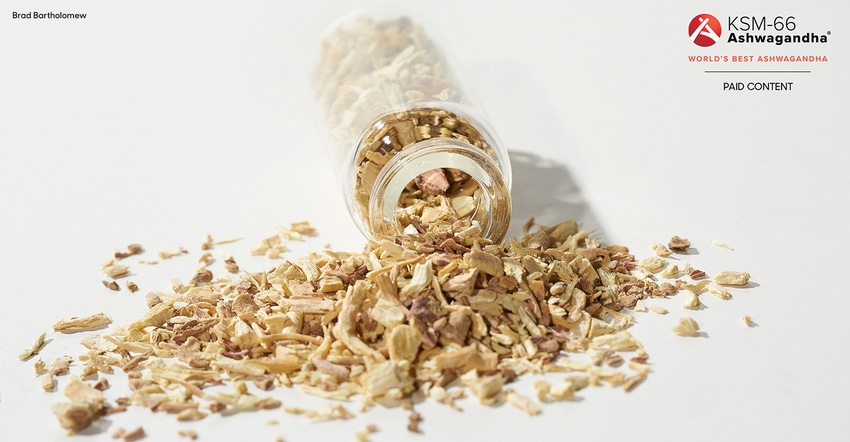Ashwagandha: Roots for wellness, leaves for soil – article
Growing interest in ashwagandha is putting pressure on the supply chain and prompting use of aerial parts in novel formulations. KSM-66 makes the case for roots.
December 1, 2023

Sponsored by KSM-66
Ashwagandha, scientifically known as Withania somnifera, holds a revered place in the ancient ayurvedic realm, often hailed as the ”King of Herbs.” For thousands of years, the roots have been used for their rich tapestry of health benefits.
The last decade has witnessed a blossoming interest in ashwagandha, both within holistic circles and mainstream markets, owing to its diverse health-promoting virtues. Market analyses forecast a vibrant growth trajectory, with projections suggesting a surge to $1.14 billion by 2028 at a compound annual growth rate of 6.4%.1
The burgeoning popularity has spurred some suppliers to explore novel formulations, notably by incorporating the aerial components of the plant, chiefly leaves, to economize on the traditionally used root extracts. However, scientists at KSM-66 see this as contrary to both ancient tradition and modern evidence.
Indian government advisory
Reacting to this emerging trend of utilizing ashwagandha leaves in formulations, the Indian Government’s Ministry of Ayush (Ayurveda, Yoga and Naturopathy, Unani, Siddha and Homeopathy) has issued an advisory, underscoring a lack of substantial evidence backing the efficacy of ashwagandha leaves. The advisory recommends the need for studies to ascertain the safety and efficacy of the leaves for various health indications, and thus discourages its therapeutic use within the ayurveda, siddha, and unani medicinal systems until further clarity emerges.
Several additional standards on the use of roots alone have been published by the Ayurvedic Pharmacopoeia, Siddha Pharmacopoeia, Unani Pharmacopoeia, American Herbal Pharmacopoeia, Indian Pharmacopoeia, British Pharmacopoeia, World Health Organization Monograph, Health Canada Monograph, and the United States Pharmacopeia.
The cost factor
A financial comparison unveils a notable difference: Ashwagandha leaves are significantly less expensive, priced at 3 cents per kg, while the roots command a price between $3 and $4 per kg. This cost disparity has seemingly enticed some suppliers to augment with leaf content in their formulations.
KSM-66 ashwagandha staunchly adheres to root-only extracts, embracing the traditional wisdom and the consequential health benefits it brings.
The company believes leaf inclusion not only dampens the economic prospects for farmers but also deprives the soil of essential organic matter that the leaves, when used as compost, would have replenished.
A sustainable story
Although the use of aerial parts in formulations is traditionally discouraged, the leaves do play a crucial role in the ecological cycle of ashwagandha cultivation. Farmers traditionally allow the leaves to naturally wither on the fields, preserving the seeds for the forthcoming season. The dried leaves and stems are reincorporated into the soil as compost, enriching the soil's organic content for the next cultivation cycle.
Hence, the roots are heralded for health, while the leaves are important as compost.
There are some entities that have been propagating a narrative around ashwagandha, especially regarding the alleged cost-effectiveness and comparable health benefits of whole plant extracts. However, the long-term impact of such formulations remains uncertain and raises questions about their adaptogenic equivalence to pure root extracts.
Furthermore, concern about waste generation through root-only extraction has been debunked as no farmer would squander the precious leaves that are key to maintaining soil fertility.
Ashwagandha root legacy
The annals of history echo with the profound healthy stress management properties of ashwagandha roots, a traditional botanical to support healthy physical, psychological and emotional stress response. Its name, ashwagandha, a blend of ”ashva” (horse) and ”gandha” (smell) in Sanskrit, symbolizes the energizing essence of its roots, while its species name ”somnifera,” from the Latin ”somnus” (sleep), hints at its sleep-promoting attributes.
Traditionally, only the roots have been used to foster strength, support sexual wellness, respiratory function and joint health, and even support female reproductive health. The leaves, on the other hand, have been confined to external applications as per ancient ayurvedic texts.
Modern science, ancient wisdom
A plethora of studies over the past quarter-century have primarily focused on ashwagandha roots, reinforcing the traditional reverence for the root’s therapeutic potential. Clinical trial registries from India, Iran, Australia, New Zealand and the United States predominantly feature studies centered on root and root-based formulations, underscoring the global scientific consensus.
The tapestry of modern research and age-old wisdom both support the virtues of ashwagandha root, unveiling a cornucopia of health benefits that could significantly enhance health and well-being. The rising global demand testifies to its intrinsic value as a medicinal plant.
KSM-66 believes that preserving the authenticity of ashwagandha's therapeutic essence necessitates an adherence to root-only extracts. This practice not only honors the rich traditional legacy but also supports the livelihoods of farmers, promotes a sustainable cultivation cycle and ensures that the legacy of ashwagandha continues to flourish.
1.) Ashwagandha Market has Huge Potential for growth by 2028, by Type, Application and Region, Covid 19 Analysis, Future Plans and Industry Growth with High CAGR by Forecast.
You May Also Like




.png?width=800&auto=webp&quality=80&disable=upscale)